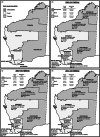Comparison of three cryptosporidiosis outbreaks in Western Australia: 2003, 2007 and 2011
- PMID: 29974834
- PMCID: PMC9133686
- DOI: 10.1017/S0950268818001607
Comparison of three cryptosporidiosis outbreaks in Western Australia: 2003, 2007 and 2011
Abstract
Cryptosporidium is a protozoan parasite that causes the diarrhoeal disease, cryptosporidiosis. Although many species have been identified, the majority of human disease worldwide is caused by two species; Cryptosporidium parvum and Cryptosporidium hominis. In Australia, data from the National Notifiable Diseases Surveillance System (NNDSS) show that cryptosporidiosis outbreaks occur every few years. To better understand the transmission, trends and nature of cryptosporidiosis outbreaks in Western Australia, epidemiological and genomic data from three cryptosporidiosis outbreaks in 2003, 2007 and 2011 were reviewed. The 2007 outbreak was the largest (n = 607) compared with the outbreaks in 2003 (n = 404) and 2011 (n = 355). All three outbreaks appeared to have occurred predominantly in the urban metropolitan area (Perth), which reported the highest number of case notifications; increases in case notifications were also observed in rural and remote areas. Children aged 0-4 years and non-Aboriginal people comprised the majority of notifications in all outbreaks. However, in the 2003 and 2007 outbreaks, a higher proportion of cases from Aboriginal people was observed in the remote areas. Molecular data were only available for the 2007 (n = 126) and 2011 (n = 42) outbreaks, with C. hominis the main species identified in both outbreaks. Subtyping at the glycoprotein 60 (gp60) locus identified subtype IbA10G2 in 46.3% and 89.5% of C. hominis isolates typed, respectively, in the 2007 and 2011 outbreaks, with the IdA15G1 subtype was identified in 33.3% of C. hominis isolates typed in the 2007 outbreak. The clustering of cases with the IdA15G1 subtype in the remote areas suggests the occurrence of a concurrent outbreak in remote areas during the 2007 outbreak, which primarily affected Aboriginal people. Both the C. hominis IbA10G2 and IdA15G1 subtypes have been implicated in cryptosporidiosis outbreaks worldwide; its occurrence indicates that the mode of transmission in both the 2007 and 2011 outbreaks was anthroponotic. To better understand the epidemiology, sources and transmission of cryptosporidiosis in Australia, genotyping data should routinely be incorporated into national surveillance programmes.
Keywords: Australia; Cryptosporidium; gp60; outbreaks.
Figures



Similar articles
-
Differences in the occurrence and epidemiology of cryptosporidiosis in Aboriginal and non-Aboriginal people in Western Australia (2002-2012).Infect Genet Evol. 2017 Sep;53:100-106. doi: 10.1016/j.meegid.2017.05.018. Epub 2017 May 20. Infect Genet Evol. 2017. PMID: 28536073
-
Molecular analysis of cryptosporidiosis cases in Western Australia in 2019 and 2020 supports the occurrence of two swimming pool associated outbreaks and reveals the emergence of a rare C. hominis IbA12G3 subtype.Infect Genet Evol. 2021 Aug;92:104859. doi: 10.1016/j.meegid.2021.104859. Epub 2021 Apr 10. Infect Genet Evol. 2021. PMID: 33848684
-
Molecular characterisation of Cryptosporidium outbreaks in Western and South Australia.Exp Parasitol. 2010 Aug;125(4):325-8. doi: 10.1016/j.exppara.2010.02.012. Epub 2010 Feb 26. Exp Parasitol. 2010. PMID: 20219461
-
A review and analysis of cryptosporidiosis outbreaks in New Zealand.Parasitology. 2023 Jun;150(7):606-611. doi: 10.1017/S0031182023000288. Epub 2023 Mar 20. Parasitology. 2023. PMID: 36938817 Free PMC article. Review.
-
A retrospective epidemiological analysis of human Cryptosporidium infection in China during the past three decades (1987-2018).PLoS Negl Trop Dis. 2020 Mar 30;14(3):e0008146. doi: 10.1371/journal.pntd.0008146. eCollection 2020 Mar. PLoS Negl Trop Dis. 2020. PMID: 32226011 Free PMC article.
Cited by
-
Molecular characterization of Cryptosporidium isolates from humans in Ontario, Canada.Parasit Vectors. 2021 Jan 22;14(1):69. doi: 10.1186/s13071-020-04546-9. Parasit Vectors. 2021. PMID: 33482898 Free PMC article.
-
Zoonoses and the Aboriginal and Torres Strait Islander population: A One Health scoping review.PLOS Glob Public Health. 2022 Oct 12;2(10):e0000921. doi: 10.1371/journal.pgph.0000921. eCollection 2022. PLOS Glob Public Health. 2022. PMID: 36962569 Free PMC article.
-
Use-case scenarios for an anti-Cryptosporidium therapeutic.PLoS Negl Trop Dis. 2021 Mar 11;15(3):e0009057. doi: 10.1371/journal.pntd.0009057. eCollection 2021 Mar. PLoS Negl Trop Dis. 2021. PMID: 33705395 Free PMC article. Review.
References
-
- Ryan U, Zahedi A and Paparini A (2016) Cryptosporidium in humans and animals-a one health approach to prophylaxis. Parasite Immunology 38, 535–547. - PubMed
-
- Xiao L (2010) Molecular epidemiology of cryptosporidiosis: an update. Experimental Parasitology 124, 80–89. - PubMed
-
- Karanis P, Kourenti C and Smith H (2007) Waterborne transmission of protozoan parasites: a worldwide review of outbreaks and lessons learnt. Journal of Water and Health 5, 1–38. - PubMed
-
- Baldursson S and Karanis P (2011) Waterborne transmission of protozoan parasites: review of worldwide outbreaks – an update 2004–2010. Water Research 45, 6603–6614. - PubMed
-
- Efstratiou A, Ongerth JE and Karanis P (2017) Waterborne transmission of protozoan parasites: review of worldwide outbreaks – an update 2011–2016. Water Research 114, 14–22. - PubMed
Publication types
MeSH terms
Substances
LinkOut - more resources
Full Text Sources
Other Literature Sources
Medical

